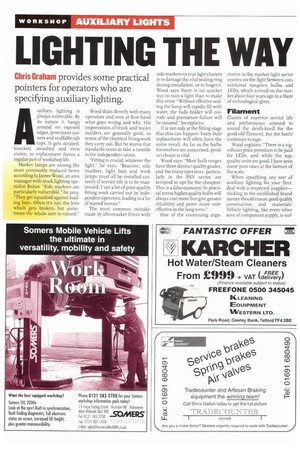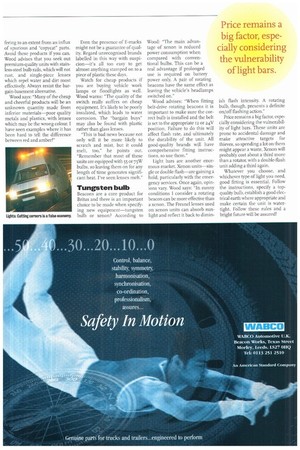LIGHTING THE WAY
Page 50

Page 51

If you've noticed an error in this article please click here to report it so we can fix it.
Chris Graham provides some practical pointers for operators who are specifying auxiliary lighting.
Auxiliary lighting is always vulnerable. By its nature it hangs around on exposed edges, prominent corners and scuffable cab tops. It gets scraped, knocked, smashed and even stolen, so replacement forms a regular part of workshop life.
Marker lamps are among the most commonly replaced items according to James Wood, an area manager with truck lighting specialist Britax. "Side markers are particularly vulnerable," he says. They get squashed against loading bays. Often it's just the lens which gets broken, but sometimes the whole unit is ruined."
Wood deals directly with many operators and sees at first hand what goes wrong and why. His impressions of truck and trailer builders are generally good, in terms of the electrical fitting work they carry out. But he warns that standards seem to take a tumble in the independent sector.
"Fitting is crucial, whatever the light," he says. "Beacons, side markers, light bars and work lamps must all be installed correctly if service life is to be maximised. I see a lot of poor-quality fitting work carried out by independent operators, leading to a lot of wasted money."
The most common mistake made by aftermarket fitters with side markers or rear light clusters is to damage the vital sealing ring during installation, or to forget it. Wood says there is no quicker way to ruin a light than to make this error. "Without effective sealing the lamp will rapidly fill with water, the bulb holder will corrode and premature failure will be assured," he explains.
It is not only at the fitting stage that this can happen: hasty bulb replacement will often have the same result. As far as the bulbs themselves are concerned, product choice is vital.
Wood says: "Most bulb ranges have three distinct quality grades, and too many operators, particularly in the PSV sector, are tempted to opt for the cheapest. This is a false economy. In practical terms higher quality bulbs will always cost more but give greater reliability and prove more costeffective in the long term."
One of the continuing argu
merits in the marker light sector centres on the fight between conventional tungsten bulbs and LEDs, which arrived on the market about four years ago in a blaze of technological glory.
Filament
Claims of superior service life and performance seemed to sound the death-knell for the good old filament, but the battle continues to rage.
Wood explains: "There is a significant price premium to be paid for LEDs, and while the topquality units are good, I have seen some poor ones at the bottom of the scale.
When specifying any sort of auxiliary lighting for your fleet, deal with a respected supplier— sticking to the established brand names should ensure good quality construction and materials. Vehicle lighting, like every other area of component supply, is suf fering to an extent from an influx of spurious and "copycat" parts. Avoid these products if you can. Wood advises that you seek out premium-quality units with stainless-steel bulb rails, which will not rust, and single-piece lenses which repel water and dirt most effectively. Always resist the bargain-basement alternative.
Wood says: "Many of the cheap and cheerful products will be an unknown quantity made from inferior materials—poor quality metals and plastics, with lenses which may be the wrong colour. I have seen examples where it has been hard to tell the difference between red and amber!" Even the presence of !-marks might not be a guarantee of quality. Regard unrecognised brands labelled in this way with suspicion—it's all too easy to get almost anything stamped on to a piece of plastic these days.
Watch for cheap products if you are buying vehicle work lamps or floodlights as well. Wood warns: "The quality of the switch really suffers on cheap equipment. It's likely to be poorly insulated, which leads to water corrosion. The "bargain buys" may also be found with plastic rather than glass lenses.
"This is bad news because not only will it be more likely to scratch and mist, but it could melt, too," he points out. "Remember that most of these units are equipped with 55 or 75W bulbs, so leaving them on for any length of time generates significant heat. I've seen lenses melt."
Tungsten bulb
Beacons are a core product for Britax and there is an important choice to be made when specifying new equipment—tungsten bulb or xenon? According to Wood: "The main advantage of xenon is reduced power consumption when compared with conventional bulbs. This can be a real advantage if prolonged use is required on battery power only. A pair of rotating beacons have the same effect as leaving the vehicle's headlamps switched on."
Wood advises: "When fitting belt-drive rotating beacons it is important to make sure the correct bulb is installed and the belt is set to the appropriate 12 or 24V position. Failure to do this will affect flash rate, and ultimately the durability of the unit. All good-quality brands will have comprehensive fitting instructions, so use them."
Light bars are another enormous market. Xenon units—single or double flash—are gaining a hold, particularly with the emergency services. Once again, opinions vary. Wood says: "In sunny conditions I consider a rotating beacon can be more effective than a xenon. The Fresnel lenses used on xenon units can absorb sunlight and reflect it back to dimin ish flash intensity. A rotating bulb, though, presents a definite on/off flashing action."
Price remains a big factor, especially considering the vulnerability of light bars. These units are prone to accidental damage and make attractive targets for thieves, so spending a lot on them might appear a waste. Xenon will probably cost about a third more than a rotator, with a double-flash unit adding a third again.
Whatever you choose, and whichever type of light you need, good fitting is essential. Follow the instructions, specify a topquality bulb, establish a good electrical earth where appropriate and make certain the unit is watertight. Follow these rules and a bright future will be assured!
















































































































